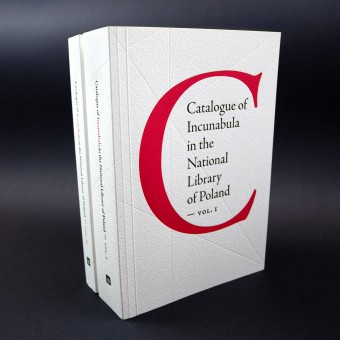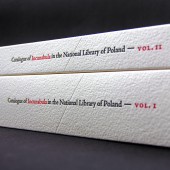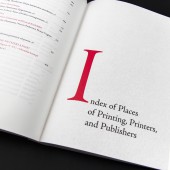Catalogue of Incunabula Book Series by Aleksandra Toborowicz |
Home > Winners > #114705 |
 |
|
||||
| DESIGN DETAILS | |||||
| DESIGN NAME: Catalogue of Incunabula PRIMARY FUNCTION: Book Series INSPIRATION: The two-volume "Catalogue of Incunabula in the National Library of Poland" presents the collection of 15th-century prints held by the BNP, the sixth-largest such collection in Poland (1,131 copies of 1,034 printed editions). Perhaps the greatest achievement of this tradition so far was the publication of the central catalogue of all incunabula in Poland; now it is the turn of the collection of the National Library, presented here in great detail. The idea of the project refers to the style of the first Renaissance prints and typography. UNIQUE PROPERTIES / PROJECT DESCRIPTION: The idea of the project refers to the style of the first Renaissance prints and typography - both in the selection of materials: elegant, hand-made cover paper and inside pages, by referring to the typography – large initials, which are the leitmotif of the project, as well as the technique of two-color typographic printing in the title of the cover. The subtle blind debossing of the Renaissance grid adds elegance to the design and strengthens historical references. An oldstyle and serif Adobe Jenson Pro font used in publication also refers to the first text face cut in Venice by Nicolas Jenson around 1470. The burgundy color of the elements organizing the publication (initials debossed on the covers and main inserts) and the accents (highlighting the most important sections, footnotes, references to footnotes) strongly contrast with the black of the body of the text. The paper used for the cover production – Arches White 400 g/m2 – is the highest quality product made of 100% cotton. Thanks to traditional production methods, the paper has a rough and harmonious texture, similar to hand-made paper. The typographic layout also refers to historical solutions from the times of incunabula. OPERATION / FLOW / INTERACTION: The publication, which consists of many pages, was prepared in the otabind binding technique, which allows for easy opening of the book and makes it easier to read. PROJECT DURATION AND LOCATION: year: 2019–2020, Kraków–Warszawa |
PRODUCTION / REALIZATION TECHNOLOGY: cover: Arches White 400 g/m2; dry embossing – lines, title text – typographic printing cover print: 2+1 printed on: Munken Premium Cream 1.3, 90 g/m2 inside print: 2+2 (czarny + Pantone 199 U) red threads typefaces: Adobe Jenson Pro, Incunables SPECIFICATIONS / TECHNICAL PROPERTIES: binding: sewn-glued binding (otabind) format: 168 x 240 mm number of pages: 1080 (vol. 1: 704, vol. 2: 392) printed by: Marceli Sp. z o.o., Warszawa circulation: 250 TAGS: catalogue, incunabula, publication, book, old-style, initials, typography, Renaissance, blind deboss, letterpress, renaissance grid, RESEARCH ABSTRACT: The Catalogue of Incunabula in the National Library of Poland continues the tradition of research into the oldest surviving examples of printing, begun by Kazimierz Piekarski before the Second World War. It was compiled by Michał Spandowski in collaboration with Slawomir Szyller. Descriptions of the bindings are by Maria Brynda. The National Library of Poland has a cooperation agreement with the Berlin State Library dating from 2011, thanks to which the Catalogue has been reviewed by Dr Falk Eisermann, head of the Gesamtkatalog der Wiegendrucke (Union Catalogue of Incunabula) in Berlin, whose division is the leading body dealing with the global bibliography of fifteenth-century prints. Paul Schweitzer-Martin, expert in incunabula at the University of Heidelberg, helped produce the English version. It was decided to publish in English due to the international nature of research in this field and so that the Catalogue would reach a wider audience. The Catalogue describes incunabula from a number of important historical collections, including the famous Biblioteka Ordynacji Zamojskiej (Count Zamoyski Family Library) and the Count Tarnowski Family Library in Dzikow. It includes descriptions of objects saved from the pre-War collection of the National Library, almost completely destroyed following the Warsaw Uprising. The Catalogue further adds to our bibliographic knowledge of fifteenth-century printing by presenting a number of unique items not covered in the existing literature. It also contains specialised descriptions of the medieval manuscripts that are bound together with the incunabula, and selected post-incunabula. The second volume of the Catalogue contains a number of research tools making it easier to use the over 1,000 individual descriptions in the first volume. In addition, two provenance indexes provide extensive information on the former owners of the incunabula, with individual owners listed separately from institutions such as libraries, monasteries and churches. CHALLENGE: The biggest challenge was to design the layout – a complex, specialized and multi-part hierarchy and typographic layout, as well as a very voluminous text material while limiting the page limit. ADDED DATE: 2020-12-21 10:57:31 TEAM MEMBERS (3) : Design: Aleksandra Toborowicz, Typesetting: Katarzyna Niewczas and Project manager: Monika Michowicz IMAGE CREDITS: Aleksandra Toborowicz, 2020. |
||||
| Visit the following page to learn more: https://bit.ly/3u2X6Nw | |||||
| AWARD DETAILS | |
 |
Catalogue of Incunabula Book Series by Aleksandra Toborowicz is Winner in Print and Published Media Design Category, 2020 - 2021.· Press Members: Login or Register to request an exclusive interview with Aleksandra Toborowicz. · Click here to register inorder to view the profile and other works by Aleksandra Toborowicz. |
| SOCIAL |
| + Add to Likes / Favorites | Send to My Email | Comment | Testimonials | View Press-Release | Press Kit |







